Cow Protection
An ancient prayer states:
O' Lord of Lords, You are the well-wisher of the cows and brahmanas, and
You are the well-wisher of the entire human society and the world.'
(Visnu Purana 1.19.65)
The protection of the cows and the bulls is one of the pillars of Vedic
spirituality.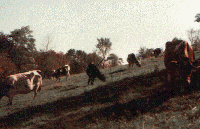 Prabhupada referred to milk as liquid religiosity.
The cow is considered a "mother" because she provides milk for human
society and the bull is a "father" because the bull helps plow the
land
Prabhupada referred to milk as liquid religiosity.
The cow is considered a "mother" because she provides milk for human
society and the bull is a "father" because the bull helps plow the
land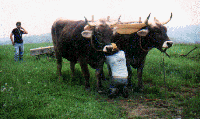 to produce the grains. The cows' milk is an important form of
nutrition, especially for children. A wide variety of sweets and eatables are produced from the milk.
Also ghee, or butter oil, is used in the cooking
and frying of vegetables and grains. Ghee is also used for worship in
the temples and is poured on the sacred fire (agnihotra) during special
ceremonies. Another important factor is that the ghee remains fresh
indefinitely without refrigeration.
to produce the grains. The cows' milk is an important form of
nutrition, especially for children. A wide variety of sweets and eatables are produced from the milk.
Also ghee, or butter oil, is used in the cooking
and frying of vegetables and grains. Ghee is also used for worship in
the temples and is poured on the sacred fire (agnihotra) during special
ceremonies. Another important factor is that the ghee remains fresh
indefinitely without refrigeration.
In ancient times, when Lord Krishna resided in Vrindavan, He personally
tended to and protected the cows, as well as maintained the
peacefulness and the natural beauty of this rural village where he grew
up. In New Vrindavan, the residents try to apply this same principle of
cow protection and even have an "Adopt A Cow" program for it's national
congregation. The cows are never to be sold and shipped off to slaughter
houses.
The cow protection program at New Vrindavan grew from one cow in 1969 to
400 cows by 1989. For the first ten years the cows were milked by
hand. Throughout the 70's the cow barn was located in the midst of
the community at Bahulaban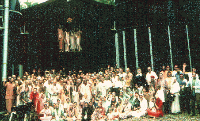 and the cows were a very important part of
community life. Every day all the residents were aware of how many
pounds of milk the cows had produced. Actually, the second floor of the
barn not only was used as storage for hay, but was partitioned into
rooms which housed some of the community residents.
and the cows were a very important part of
community life. Every day all the residents were aware of how many
pounds of milk the cows had produced. Actually, the second floor of the
barn not only was used as storage for hay, but was partitioned into
rooms which housed some of the community residents.
In the early 80's, the community built a new worship and residential
complex 3 miles up the road, past the Palace of Gold. A large dairy
facility was also built 1 1/2 miles past the new complex.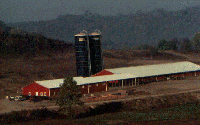 Kirtanananda and some of the community management wanted to have the
biggest dairy herd in West Vriginia, and abruptly started to increase
the herd's size. The dairy included an automated milking pallor
Kirtanananda and some of the community management wanted to have the
biggest dairy herd in West Vriginia, and abruptly started to increase
the herd's size. The dairy included an automated milking pallor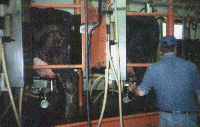 that
processed the milk of the 80 or so milking cows (out of a total herd of
400). Most of the milk was sold to a local dairy company. Only a
fraction of the milk was used by the community. With this expansion, the
cows were no longer an intimate part of community life. For several years
the dairy staff also included local area workers who were hired to milk
the cows and maintain the facility. Financially, the dairy operation was
not at all viable. By the mid 90's the dairy facility had become a
burden upon the community, which had been dwindling in membership and
economic support.
that
processed the milk of the 80 or so milking cows (out of a total herd of
400). Most of the milk was sold to a local dairy company. Only a
fraction of the milk was used by the community. With this expansion, the
cows were no longer an intimate part of community life. For several years
the dairy staff also included local area workers who were hired to milk
the cows and maintain the facility. Financially, the dairy operation was
not at all viable. By the mid 90's the dairy facility had become a
burden upon the community, which had been dwindling in membership and
economic support.
As of 2001, the community still maintains a herd of about 160 cows,
including 10 milking. The milking cows are housed in a new and smaller
dairy facility right by the temple and living complex. The cows are
milked by hand by the devotees and their milk is used in the
community.
Additional Images
1
2
3
4
5
6

